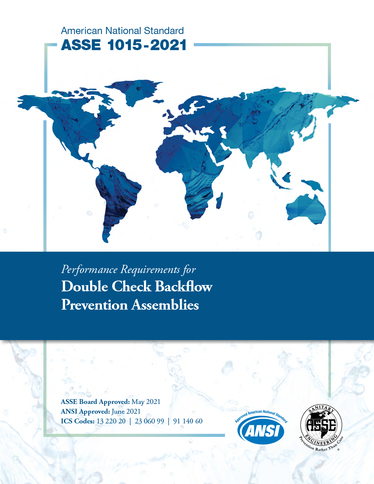There are many types of backflow protection devices and assemblies – each is designed for a specific application – but the most prominent of these are the double check valve (DC) and reduced pressure (RP) types of protection assemblies.
The performance requirements for these assemblies can be found in ASSE 1013-2021, Performance Requirements for Reduced Pressure Principle Backflow Prevention Assemblies, ASSE 1015-2021, Performance Requirements for Double Check Backflow Prevention Assemblies, ASSE 1047-2021, Performance Requirements for Reduced Pressure Detector Backflow Prevention Assemblies, and ASSE 1048-2021, Performance Requirements for Double Check Detector Backflow Prevention Assemblies. From here forward, these standards will be referred to as the “RP/DC” standards. All of the above-mentioned backflow prevention assemblies provide protection for backpressure and backsiphonage. In warmer climates, you will often see the larger versions of these assemblies above ground.
The RP/DC standards were revised recently and published as new editions (ANSI Approved in June 2021). It is necessary to review and revise standards periodically to ensure that they remain current with technological advances and industry practices. These standards were last revised in 2011.
These four standards have very similar testing methods and criteria with only slight differences between them. Over time, due to revisions of these standards occurring at different times, the language used to describe the same exact method or clause became unique in each standard. A goal with this revision cycle was to reconcile the language to be the same across the standards to eliminate confusion for users. In the past, it was often perceived that the methods between standards were technically different because the language was different. Having consistent methods also benefits laboratories and testing agencies. Common language allows for conformity of training and improved understanding as to the intent of the standards.
So, what else has changed between the revisions? Perhaps the most noticeable change is in the titles, which no longer have fire protection in the name.
With regard to ASSE 1013 and ASSE 1015, a previous category of assemblies was included in the standard – double check fire protection backflow preventers. This was a type of low-pressure loss assembly that no manufacturer ever produced or offered into commerce. Instead, fire sprinkler systems are almost universally protected by assemblies conforming to ASSE 1047 or ASSE 1048. For these reasons, this category was removed from the standards.
However, in the case of ASSE 1047 and ASSE 1048, these assemblies can be used for fire protection. But the requirements for these assemblies, regardless of application, is the same. So, again, there was no need for a special category of device.
As you look further into the scope of the standard, you will find that manifolds are no longer included in the RP/DC standards. The two or more backflow preventers found in a manifold were tested the same as individual backflow preventers. This was redundant and, thus, was removed.
A design requirement that requires the assemblies to be serviced and maintained using commercially available tools was also added. While this seems like common sense, it was not a requirement in the past.
Now, to discuss the more technical aspects of the changes. Since the language in the standards are similar and have been reconciled, we will discuss the changes collectively. The below is true for all four RP/DC standards (this is a summary and not all inclusive).
Within the scope, the temperature range has been split into temperature ranges for assemblies used in cold water applications and assemblies used in hot water applications. Respectively, these are 33.0°F to 140.0°F and 33.0°F to 180.0°F. This allows for cold water only assemblies to be tested at the maximum value of the range for which they are designed.
Also note that the top of the hot water range has increased from 140°F to 180°F. This higher temperature is in line with industry applications of the assemblies. Similarly, the maximum working pressure shall be at least 175psi. This is up from the previous 150psi. Again, we are keeping the standard current with how the assemblies are being used. I should note that in the cases where testing is conducted at twice the manufacture’s maximum pressure, the new minimum test pressure is 350psi.
You will also notice that the life cycle test method looks very different. While the new formatted method might look intimidating, it is essentially the same method. Care was taken to define the method in numerical steps. The different phases of testing were annotated to assist in understanding the intent of the different sections.
This does not mean that there were no technical changes made in the life cycle test method, as some testing parameters did change. The flowing pressure used during the life cycle was raised from 30psi to 60psi. This better challenges the product with conditions found in the field. Also, the maximum pressure for testing is now 175psi (formerly 150 psi). This is in keeping with the change to the pressure range.
There is one notable change which only applies to ASSE 1013 and ASSE 1047 – when conducting the relief valve discharge test, an alternate method for determining the discharge rate has been added. The standards now allow for the use of a weight tank in place of the flow meter. This is a common practice used by test laboratories to quantify small amounts of flow and should be permitted.
There are additional changes not identified here. This article was intended to highlight the more significant changes and to show that the standards continue to be robust in specifying requirements. There were also the usual changes to improve the readability and to remove any ambiguity that may have existed. Anyone interested in understanding these and other changes are encouraged to read through the 2021 editions of the RP/DC standards.
Article by Terry Burger first appeared in Working Pressure magazine
Last modified: December 19, 2023

